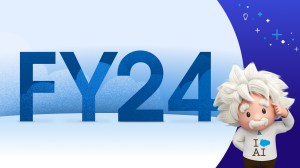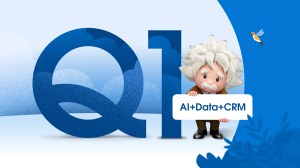• Quarterly Revenue of $732 Million, up 34% Year-Over-Year
• Quarterly Operating Cash Flow of $136 Million, up 64% Year-Over-Year
• Deferred Revenue of $1.34 Billion, up 43% Year-Over-Year
• Unbilled Deferred Revenue Increases to Approximately $2.8 Billion
• Raises FY13 Revenue Guidance to $3.025 – $3.035 Billion
SAN FRANCISCO, August 23, 2012 – Salesforce.com [NYSE: CRM], the enterprise cloud computing (http://www.salesforce.com/cloudcomputing/) company, today announced results for its fiscal second quarter ended July 31, 2012.
“Our second quarter revenue growth was outstanding at 34% in dollars and 37% in constant currency,” said Marc Benioff, Chairman and CEO, salesforce.com. “Salesforce.com’s social enterprise strategy is enabling companies to connect with customers, partners, and employees in completely new ways – and it’s creating new opportunities for their growth and ours.”
Salesforce.com delivered the following results for its fiscal second quarter:
Revenue: Total Q2 revenue was $732 million, an increase of 34% on a year-over-year basis. Subscription and support revenues were $687 million, an increase of 35% on a year-over-year basis. Professional services and other revenues were $44 million, an increase of 20% on a year-over-year basis.
Earnings per Share: Q2 GAAP net loss per share was ($0.07), and non-GAAP diluted earnings per share was $0.42. The company’s non-GAAP results exclude the effects of $85 million in stockbased compensation expense, $20 million in amortization of purchased intangibles, and $6 million in net non-cash interest expense related to the company’s convertible senior notes. Non-GAAP EPS calculations are based on approximately 146 million diluted shares outstanding during the quarter, including approximately 3 million shares associated with the company’s convertible senior notes. GAAP EPS calculations are based on a basic share count of approximately 139 million shares.
Cash: Cash generated from operations for the fiscal second quarter was $136 million, an increase of 64% on a year-over-year basis. Total cash, cash equivalents and marketable securities finished the quarter at $1.8 billion.
Deferred Revenue: Deferred revenue on the balance sheet as of July 31, 2012 was $1.34 billion, an increase of 43% on a year-over-year basis. Current deferred revenue increased by 38% yearover- year to $1.27 billion, benefited in part by longer invoice durations. Non-current deferred revenue increased by 293% year-over-year to $69 million. Unbilled deferred revenue, representing business that is contracted but unbilled and off balance sheet, ended the second quarter at approximately $2.8 billion, up from approximately $2.7 billion at the end of the fiscal first quarter.
As of August 23, 2012, salesforce.com is initiating revenue, GAAP EPS and non-GAAP EPS guidance for its fiscal third quarter of fiscal year 2013. In addition, for the full fiscal year 2013, the company is raising its revenue and non-GAAP EPS guidance previously provided on June 4, 2012, and initiating GAAP EPS guidance.
Q3 FY13 Guidance: Revenue for the company’s third fiscal quarter is projected to be in the range of $773 million to $777 million, an increase of 32% to 33% year-over-year.
GAAP net loss per share is expected to be in the range of ($0.27) to ($0.26), while diluted non-GAAP EPS is expected to be in the range of $0.31 to $0.32. The non-GAAP estimate excludes the effects of stock-based compensation expense, expected to be approximately $99 million, amortization of purchased intangibles related to acquisitions, expected to be approximately $27 million, and net noncash interest expense related to the convertible senior notes, expected to be approximately $6 million. EPS estimates assume a GAAP tax rate of approximately 37%, and a non-GAAP tax rate of approximately 35%. The GAAP EPS calculation assumes an average basic share count of approximately 142 million shares, and the non-GAAP EPS calculation assumes an average fully diluted share count of approximately 151 million shares.
Full Year FY13 Guidance: Revenue for the company’s full fiscal year 2013 is projected to be in the range of $3.025 billion to $3.035 billion, an increase of 33% to 34% year-over-year.
For the company’s full fiscal year 2013, GAAP net loss per share is expected to be in the range of ($0.75) to ($0.72) while diluted non-GAAP EPS is expected to be in the range of $1.48 to $1.51. The non-GAAP estimate excludes the effects of stock-based compensation expense, expected to be approximately $382 million, amortization of purchased intangibles related to acquisitions, expected to be approximately $95 million, and net non-cash interest expense related to the convertible senior notes, expected to be approximately $24 million. EPS estimates assume a GAAP tax rate of approximately 30%, and a non-GAAP tax rate of approximately 37%. The GAAP EPS calculation assumes an average basic share count of approximately 141 million shares, and the non-GAAP EPS calculation assumes an average fully diluted share count of approximately 150 million shares.
The following is a per share reconciliation of GAAP EPS to non-GAAP diluted EPS guidance for the third quarter and full fiscal year:
Quarterly Conference Call
Salesforce.com will host a conference call to discuss its second quarter fiscal year 2013 results at 2:00 p.m. Pacific Time today. A live audio webcast of the conference call, together with detailed financial information, can be accessed through the company’s Investor Relations Web site at http://www.salesforce.com/investor. In addition, an archive of the audiocast can be accessed through the same link. Participants who choose to call in to the conference call can do so by dialing domestically 866-901-SFDC or 866-901-7332 and internationally at +1 706-902-1764, passcode salesforce.com or 17262326. A replay will be available at 800-585-8367 or +1 855-859-2056, passcode 17262326, until midnight (Eastern Time) September 23, 2012.
###
Non-GAAP Financial Measures: This press release includes information about non-GAAP EPS and non-GAAP tax rates (collectively the “non-GAAP financial measures”). Non-GAAP EPS estimates exclude the impact of the following non-cash items: stock-based compensation, amortization of acquisition-related intangibles, and the net amortization of debt discount on the company’s convertible senior notes, as well as the tax consequences associated with these items. The purpose of the non- GAAP tax rate is to quantify the excluded tax consequences of the excluded expense items. These non- GAAP estimates are not measurements of financial performance prepared in accordance with U.S. generally accepted accounting principles. The method used to produce non-GAAP financial measures is not computed according to GAAP and may differ from the methods used by other companies. Non- GAAP financial measures are not meant to be considered in isolation or as a substitute for comparable GAAP measures and should be read only in conjunction with the company’s consolidated financial statements prepared in accordance with GAAP.
The primary purpose of these non-GAAP measures is to provide supplemental information that may prove useful to investors who wish to consider the impact of certain non-cash items on the company’s operating performance. Non-cash stock-based compensation, amortization of acquisition-related intangible assets, and the net amortization of debt discount on the company’s convertible senior notes are being excluded from the company’s FY13 financial results because the decisions which gave rise to these expenses were not made to increase revenue in a particular period, but were made for the company’s long-term benefit over multiple periods. While strategic decisions, such as those to issue stock-based compensation, acquire a company, or issue convertible senior notes, are made to further the company’s long-term strategic objectives and impact the company’s income statement under GAAP measures, these items affect multiple periods and management is not able to change or affect these items in any particular period. As such, supplementing GAAP disclosure with non-GAAP disclosure using the non-GAAP measures provides management with an additional view of operational performance by excluding expenses that are not directly related to performance in any particular period, and management uses both GAAP and non-GAAP measures when planning, monitoring, and evaluating the company’s performance.
In addition, the majority of the company’s industry peers report non-GAAP operating results that exclude certain non-cash or non-recurring items. As significant unusual or discrete events occur, the results may be excluded in the period in which the events occur. Management believes that the provision of supplemental non-GAAP information will enable a more complete comparison of the company’s relative performance.
Specifically, management is excluding the following items from its non-GAAP EPS for Q2 and its non- GAAP estimates for Q3 and FY13:
•Stock-Based Expenses: The company’s compensation strategy includes the use of stock-based compensation to attract and retain employees and executives. It is principally aimed at aligning their interests with those of our stockholders and at long-term employee retention, rather than to motivate or reward operational performance for any particular period. Thus, stock-based compensation expense varies for reasons that are generally unrelated to operational decisions and performance in any particular period.
•Amortization of Purchased Intangibles: The company views amortization of acquisition-related intangible assets, such as the amortization of the cost associated with an acquired company’s research and development efforts, trade names, customer lists and customer relationships, as items arising from pre-acquisition activities determined at the time of an acquisition. While it is continually viewed for impairment, amortization of the cost of purchased intangibles is a static expense, one that is not typically affected by operations during any particular period.
•Amortization of Debt Discount: Under GAAP, certain convertible debt instruments that may be settled in cash (or other assets) on conversion are required to be separately accounted for as liability (debt) and equity (conversion option) components of the instrument in a manner that reflects the issuer’s non-convertible debt borrowing rate. Accordingly, for GAAP purposes we are required to recognize imputed interest expense on the company’s $575 million of convertible subordinated notes that were issued in a private placement in January 2010. The imputed interest rate is approximately 5.9%, while the actual coupon interest rate of the notes is 0.75%. The difference between the imputed interest expense and the coupon interest expense, net of the interest amount capitalized, is excluded from management’s assessment of the company’s operating performance because management believes that this non-cash expense is not indicative of ongoing operating performance. Management believes that the exclusion of the non-cash interest expense provides investors an enhanced view of the company’s operational performance.
•Income Tax Effects: The company’s estimated non-GAAP effective tax rate excludes the tax effect of the expense items described above.
###
“Safe harbor” statement under the Private Securities Litigation Reform Act of 1995: This press release contains forward-looking statements about expected GAAP revenue and GAAP and non-GAAP EPS for the third fiscal quarter of 2013 and the full fiscal year, the company’s expected revenue run rate and revenues in fiscal 2013, the company’s expected tax rates, stock-based compensation expenses, amortization of purchased intangibles and debt discount, and shares outstanding. The achievement or success of the matters covered by such forward-looking statements involves risks, uncertainties and assumptions. If any such risks or uncertainties materialize or if any of the assumptions prove incorrect, the company’s results could differ materially from the results expressed or implied by the forward-looking statements we make.
The risks and uncertainties referred to above include – but are not limited to – risks associated with possible fluctuations in the company’s financial and operating results; the company’s rate of growth and anticipated revenue run rate, including the company’s ability to convert deferred revenue and unbilled deferred revenue into revenue and, as appropriate, cash flow, and the continued growth and ability to maintain deferred revenue and unbilled deferred revenue; errors, interruptions or delays in the company’s service or the company’s Web hosting; breaches of the company’s security measures; the financial impact of any previous and future acquisitions; the nature of the company’s business model; the company’s ability to continue to release, and gain customer acceptance of, new and improved versions of the company’s service; successful customer deployment and utilization of the company’s existing and future services; changes in the company’s sales cycle; competition; various financial aspects of the company’s subscription model; unexpected increases in attrition or decreases in new business; the emerging markets in which we operate; unique aspects of entering or expanding in international markets, the company’s ability to hire, retain and motivate employees and manage the company’s growth; changes in the company’s customer base; technological developments; regulatory developments; litigation related to intellectual property and other matters, and any related claims, negotiations and settlements; unanticipated changes in the company’s effective tax rate; fluctuations in the number of shares we have outstanding and the price of such shares; foreign currency exchange rates; collection of receivables; interest rates; the expenses associated with the company’s real estate and office facilities space; and general developments in the economy, financial markets, and credit markets.
Further information on these and other factors that could affect the company’s financial results is included in the reports on Forms 10-K, 10-Q and 8-K and in other filings we make with the Securities and Exchange Commission from time to time, including the company’s Form 10-Q that will be filed for the second quarter ended July 31, 2012 and our Form 10-K filed for the fiscal year ended January 31, 2012. These documents are available on the SEC Filings section of the Investor Information section of the company’s website at www.salesforce.com/investor.
Salesforce.com, inc. assumes no obligation and does not intend to update these forward-looking statements, except as required by law.
Copyright © 2012 salesforce.com, inc. All rights reserved. Salesforce, Chatter, Sales Cloud, Service Cloud, Marketing Cloud, Rypple, AppExchange, Salesforce Platform, and others are trademarks of salesforce.com, inc. Other names used herein may be trademarks of their respective owners.
To view the remainder of the FY13Q2 financials on this press release, please click here to download the PDF.
About Salesforce
Salesforce is the global leader in Customer Relationship Management (CRM), bringing companies closer to their customers in the digital age. Founded in 1999, Salesforce enables companies of every size and industry to take advantage of powerful technologies—cloud, mobile, social, internet of things, artificial intelligence, voice and blockchain—to create a 360° view of their customers. For more information about Salesforce (NYSE: CRM), visit: www.salesforce.com.
Any unreleased services or features referenced in this or other press releases or public statements are not currently available and may not be delivered on time or at all. Customers who purchase Salesforce applications should make their purchase decisions based upon features that are currently available. Salesforce has headquarters in San Francisco, with offices in Europe and Asia, and trades on the New York Stock Exchange under the ticker symbol “CRM.” For more information please visit https://www.salesforce.com, or call 1-800-NO-SOFTWARE.
About Salesforce
Salesforce is the #1 AI CRM, empowering companies to connect with their customers in a whole new way through the power of CRM + AI + Data + Trust on one unified platform: Einstein 1. For more information visit: www.salesforce.com.
Any unreleased services or features referenced in this or other press releases or public statements are not currently available and may not be delivered on time or at all. Customers who purchase Salesforce applications should make their purchase decisions based upon features that are currently available. Salesforce has headquarters in San Francisco, with offices in Europe and Asia, and trades on the New York Stock Exchange under the ticker symbol "CRM." For more information please visit https://www.salesforce.com, or call 1-800-NO-SOFTWARE.












